Node in Javascript Diagram
19 Oct 202214 minutes to read
Nodes are graphical objects used to visually represent the geometrical information, process flow, internal business procedure, entity, or any other kind of data.
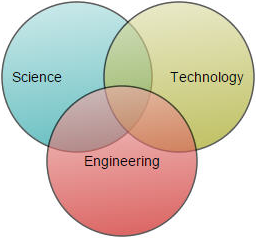
Create Node
A node can be created and added to the Diagram, either programmatically or interactively. Nodes are stacked on the Diagram area from bottom to top in the order they are added.
Add node through nodes collection
To create a node, You have to define the node object and add that to nodes collection of the Diagram model. The following code example illustrates how to add a node to the Diagram.
// Defines JSON to create a node
var node = {
//Name of the node
name: "node1",
//Sets the size
width: 100,
height: 100,
//Sets the position
offsetX: 250,
offsetY: 250,
//Customizes the appearance
fillColor: "darkcyan",
borderWidth: 2
};
//Adds node to nodes collection
var nodes = [];
nodes.push(node);
//Initializes Diagram
$("#diagram").ejDiagram({
width: "100%", height: "100%",
//Initializes nodes collection
nodes: nodes
});
Add/Remove node at runtime
-
Nodes can be added at runtime by using public method, add and can be removed at runtime by using public method, remove.
-
To add a node to group at runtime, define group name in node’s parent property.
-
The node’s name property is used to define the name of the node and its further used to find the node at runtime and do any customization.
-
A public method findNode is used to find the node/connector at runtime.
The following code illustrates how to add a node.
// Defines JSON to create a node
var node = {
name: "node1",
width: 100,
height: 100,
//Sets position
offsetX: 250,
offsetY: 250,
fillColor: "darkcyan",
borderWidth: 2
};
var diagram = $("#diagram").ejDiagram("instance");
// Adds node to the Diagram
diagram.add(node);
When a node is either added or removed in diagram, the nodeCollectionChange event raised.
Add node from palette
Nodes can be predefined and added to palette and can be dropped into the Diagram when needed. For more information about adding nodes from symbol palette, refer to Symbol Palette.
- Once we drag a node/connector from the palette to diagram, you can use the below events to do your customization.
- When a symbol is dragged into diagram from symbol palette, the dragEnter event gets triggered.
- When a symbol is dragged over diagram,the dragOver event gets triggered.
- When a symbol is dragged and dropped from symbol palette to diagram area, the drop event gets triggered.
- When a symbol is dragged outside of the diagram, the dragLeave event gets triggered.
Create node through data source
Nodes can be generated automatically with the information provided through data source. The default properties for these nodes are fetched from default settings. For more information about data source, refer to Data Binding.
Draw nodes
Nodes can be interactively drawn by clicking and dragging the Diagram surface by using DrawingTool. For more information about drawing nodes, refer to Draw Nodes.
Update Node at runtime
The client side method updateNode is used to update the nodes at run time. The following code example illustrates how to update a node at runtime.
var diagram = $("#DiagramContent").ejDiagram("instance");
diagram.updateNode("nodeName", {
fillColor: "#1BA0E2",
borderWidth: 5,
borderColor: "#000000"
})When the node/connector properties are changed at runtime, the propertyChange event gets triggered.
Position
-
Position of a node is controlled by using its offsetX and offsetY properties. By default, these offset properties represent the distance between origin of the Diagram’s page and node’s center point.
-
You may expect this offset values to represent the distance between page origin and node’s top left corner instead of center. pivot property helps solve this problem. Default value of node’s pivot point is (0.5, 0.5), that means center of Node.
-
The size of the node can be controlled by using its width and height properties.
-
Rotation of a node is controlled by using its rotateAngle property.
-
You can update the above properties at runtime using updateNode method.
The following table illustrates how pivot relates offset values with node boundaries.
| Pivot | Offset |
|---|---|
| (0.5,0.5) | offsetX and offsetY values are considered as the node’s center point. |
| (0,0) | offsetX and offsetY values are considered as the top left corner of node |
| (1,1) | offsetX and offsetY values are considered as the bottom right corner of the node. |
The following code illustrates how to change the pivot value.
// Defines JSON to create node
var nodes = [{
name: "node", offsetX: 100, offsetY: 100,
height: 100, width: 100,
shape: "rectangle",
//Sets pivot point
pivot: ej.datavisualization.Diagram.Point(0, 0)
}];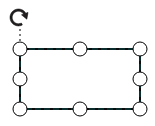
Types
Diagram allows to add different kind of nodes. To explore the types of nodes, refer to Types of Nodes.
Appearance
-
You can customize the appearance of a node by changing its fillColor, borderColor, borderWidth, borderDashArray, opacity, patterns and shadow.
-
The cssClass property of the node used to customize the style of label using user defined CSS class.
-
The visible property of the node enables or disables the visibility of node.
The following code illustrates how to customize the appearance of the shape.
var nodes = [{
name: "node1",
width: 100, height: 100,
offsetX: 250, offsetY: 250,
//Sets styles to a node to customize the appearance
fillColor: "darkcyan",
borderWidth: 2,
borderColor: "black",
borderDashArray: "5 5",
}];
//Initializes Diagram
$("#diagram").ejDiagram({
width: "100%",
height: "100%",
//Initializes nodes collection
nodes: nodes
});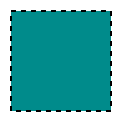
Gradient
-
The gradient property of node allows you to define and applies the gradient effect to that node.
-
The gradient stop property defines the color and a position where the previous color transition ends and a new color transition starts.
-
The gradient.stop’s opacity property defines the transparency level of the region.
There are two types of gradients.
-
Linear gradient - Defines a smooth transition between a set of colors (so-called stops) on a line.
-
A Linear gradient’s x1, y1, x2, y2 properties are used to define the position(relative to node) of the rectangular region that needs to be painted.
-
Radial gradient - Defines a smooth transition between stops on a circle.
-
A Radial gradient’s cx, cy, fx , fy properties are used to define the position(relative to node) of the outer most or inner most circle of the radial gradient.
-
A Linear gradient’s type and radial gradient’s type property is used to define the type of the gradient.
//Creates linear gradient
var linearGradient = {
type: "linear",
//Start point of linear gradient
x1: 0, y1: 0,
//End point of linear gradient
x2: 50, y2: 50,
//Sets an array of stop objects
stops: [
{ color: "white", offset: 0 },
{ color: "darkCyan", offset: 100 }
]
};
//Creates radial gradient
var radialGradient = {
type: "radial",
//Center point of outer circle
cx: 50, cy: 50,
//Center point of inner circle
fx: 25, fy: 25,
//Radius of a radial gradient
r: 50,
//Sets an array of stop objects
stops: [
{ color: "white", offset: 0 },
{ color: "darkCyan", offset: 100 }
]
};
var nodes = [{
name: "node1",
width: 100, height: 100,
offsetX: 250, offsetY: 250,
//Sets styles to a node to customize the appearance
fillColor: "darkcyan",
borderWidth: 2,
gradient: linearGradient
}];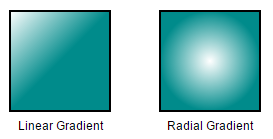
Shadow
Diagram provides support to add shadow effect to a node that is disabled by default. It can be enabled with the constraints property of node. The following code illustrates how to drop shadow.
var nodeConstraints = ej.datavisualization.Diagram.NodeConstraints;
//Enables Shadow effect for a node.
var constraints = nodeConstraints.Default | nodeConstraints.Shadow;
// Defines JSON to create path node
var nodes = [{
name: "node", offsetX: 100, offsetY: 100,
height: 100, width:100,
//Sets shape of node
shape: "rectangle",
//Enables Shadow for the node.
constraints: constraints
}];
The following code illustrates how to disable shadow effect at runtime.
var diagram = $("#diagram").ejDiagram("instance");
var node = diagram.findNode("node");
var nodeConstraints = ej.datavisualization.Diagram.NodeConstraints;
//Disables Shadow effect for a node.
constraints = node.constraints & ~nodeConstraints.Shadow;
diagram.updateNode("node", { constraints: constraints });Customizing Shadow
The angle, distance, and opacity of the shadow can be customized with the shadow property of node. The following code example illustrates how to customize shadow.
var nodes = [{
name: "node", offsetX: 100, offsetY: 100,
height: 100, width: 100,
//Sets shape of node
shape: "rectangle",
//Enables Shadow for the node.
constraints: constraints,
//Customizes shadow effect
shadow: { opacity: 0.8, distance: 9, angle: 50}
}];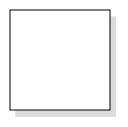
Icon
Diagram provides support to describe the state of the node. i.e., node is expanded or collapsed state.
NOTE
Icon can be created only when the node has outedges.
-
To explore the properties of expand and collapse icon, refer to expandIcon and collapseIcon.
-
The expandIcon’s shape property and collapseIcon’s shape property allows to define the shape of the icon.
The following code example illustrates how to create icon of various shapes.
// Defines JSON to create a node
var nodes = [{
name: "node1", offsetX: 100, offsetY: 100,
height: 100, width:100,
//Sets shape of node
shape: "rectangle",
//Sets properties for expandIcon
expandIcon:{ shape:"arrowdown", width:10, height:10 },
//Sets properties for collapseIcon
collapseIcon:{ shape:"arrowup", width:10, height:10 }
},
name: "node2", offsetX: 100, offsetY: 100,
height: 100, width:100,
//Sets shape of node
shape: "rectangle",
];
// Defines JSON to create a node
var connectors = [{
name: "connect", sourceNode: "node1", targetNode: "node2"
}];
//Initializes Diagram
$("#diagram").ejDiagram({
width: "100%", height: "100%",
//Initializes nodes collection
nodes: nodes
connectors: connectors
});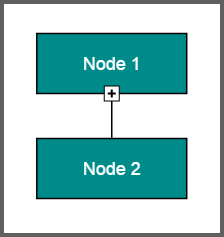

Customizing Expand Icon
-
You can set an borderColor, borderWidth, background color for an expandIcon using borderColor,borderWidth and fillColor properties.
-
To set an size for expandIcon, use width and height properties.
-
The expand icon can be aligned relative to the node boundaries. It has margin, offset, horizontalAlignment and verticalAlignment settings. It is quite tricky when all four alignments are used together but gives you more control over alignment.
Customizing Collapse Icon
-
You can set an borderColor, borderWidth, background color for an collapseIcon using borderColor,borderWidth and fillColor properties.
-
To set an size for collapseIcon, use width and height properties.
-
Like expand icon, collapse icon also can be aligned relative to the node boundaries. It has margin, offset, horizontalAlignment and verticalAlignment settings. It is quite tricky when all four alignments are used together but gives you more control over alignment.
Interaction
Diagram provides support to drag, resize, or rotate the node interactively. For more information about editing a node at runtime, refer to Edit Nodes.
Constraints
The constraints property of node allows you to enable/disable certain features. For more information about node constraints, refer to Node Constraints.
Custom Properties
The addInfo property of node allows to maintain additional information to node.
Stack Order
The nodes zOrder property specifies the stack order of an node. An node with greater stack order is always in front of an node with a lower stack order.